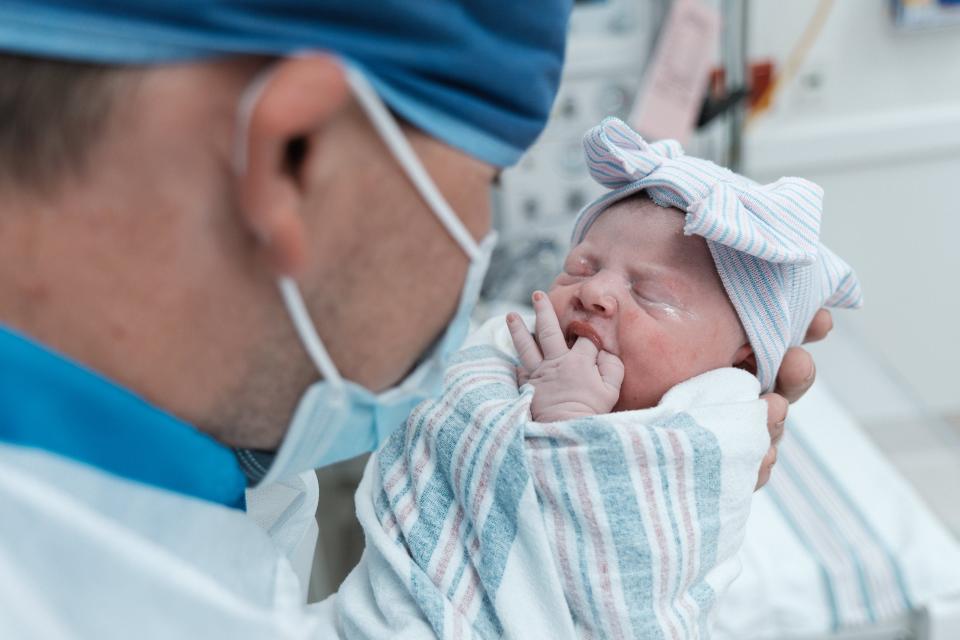This virus is a leading cause birth defects. Why isn't it screened more?
A leading cause of birth defects is a virus that many expectant parents have never heard about. That may change soon thanks to the advocacy of parents whose children suffered birth defects due to the common virus: they've made a breakthrough this week, securing screenings within hours of birth for newborn babies.
Cytomegalovirus, or CMV, infects more than half of adults over their lifetime, typically presenting no symptoms even as it stays within a person’s body. One in every 200 babies has congenital CMV at birth, according to the Centers for Disease Control and Prevention. About a fifth of babies born with CMV show symptoms, which can include smaller head size, liver and lung problems, hearing loss, or a rash, and some later show developmental delays.
New York this week joined a growing number of states to universally screen early for CMV, prompted, in large part, by parents whose children have experienced health effects from the virus. On Monday, New York begins a one-year pilot, testing all newborns for CMV using the routine method of a heel prick that leaves a dried blood spot on filter paper.
State officials already screen for dozens of diseases and genetic disorders. With CMV screening, they'll now test blood for evidence of viral DNA. It’s important to identify the virus within the first three weeks of life, pediatricians say, because during that critical period, physicians can take steps to avert serious health effects through monitoring and treatment.
“There are interventions you can offer that can improve the child's life,” said Dr. Mark Schleiss, a professor of pediatrics at the University of Minnesota Medical School affiliated with M Health Fairview Masonic Children’s Hospital, in Minneapolis. “Those include monitoring for hearing loss, monitoring their neurologic development, and in some cases, treating them with an antiviral medication that can mitigate the damage to the developing brain and the developing ear.”
Medical needs: Abortion restrictions repel graduating OB-GYNs from conservative states, report shows
There is no vaccine for CMV. But awareness about prevention and intervention could have helped mothers like Lisa Saunders, 62, whose daughter Elizabeth was born, in 1989, small for her age with microcephaly, a condition that causes a person to have a smaller head. The condition is associated with congenital CMV.
During her pregnancy, Saunders was raising her toddler and ran a day care center in her Maryland home, where she could have been exposed to the virus. The spread of CMV is common among young children. It typically spreads from contact with urine, saliva, or other bodily fluids.

“Why didn’t anyone tell me?” she said. “Why didn’t I know?”
Elizabeth had profound brain damage. As a teen, she still couldn’t lift her head, Saunders said. Elizabeth had worsening seizures and died from one at age 16.
After her daughter’s death, Saunders said she had a recurring nightmare of being in a classroom, sitting in a circle with other parents looking to her to speak. In the dream, she couldn't get any words out, and then she'd wake up. She credits that experience with helping launch years of advocacy to warn parents about CMV.
History and health: How one health study, inspired by FDR's death, changed life in America forever
What is CMV screening?
Public awareness campaigns by Saunders, her husband Jim, and other parents propelled legislation and policies for CMV screenings. The National CMV Foundation, a nonprofit where Saunders has served as a parent representative, tallied around 20 states with some screening for the virus.
Minnesota became the first state to enact universal screening for CMV in February, at the behest of local parents. In the first six months, Jill Simonetti, Minnesota’s newborn screening program manager, said more than 32,000 babies were born, and 102 of them screened as positive for CMV using dried blood spot tests. These infants received monitoring and treatment as a result, which could prevent the onset of some symptoms.
In Connecticut, where Saunders lived for several years, she helped the state to pass a law requiring universal CMV screening, beginning in 2025.
Saunders now lives near Syracuse, New York. In 2022, Gov. Kathy Hochul signed Elizabeth’s Law, named after Saunders' daughter, which requires day care workers to undergo training about the risk of CMV transmission.
With its pilot program, New York is the largest state to enact CMV screening. It's available to about 220,000 babies born annually in the state. State Rep. Linda Rosenthal, a Manhattan Democrat who sponsored Elizabeth's Law, now has a bill before the Legislature following New York’s pilot, that would make universal screening permanent. It expands on a 2018 law Rosenthal sponsored that mandates hospitals test babies for CMV if they fail a hearing screening.

The plan is to compare babies who failed a hearing screening with those who tested positive for CMV to babies who did not fail hearing tests, said Dr. Michele Caggana, director of the New York State Department of Health Newborn Screening Program, which now is overseeing the $1.36 million pilot program funded by the federal Eunice Kennedy Shriver National Institute of Child Health and Human Development.
If CMV is found within the first 24 to 36 hours of birth, officials can connect families with primary care pediatricians and specialists to monitor and address neurologic, hearing and vision outcomes if problems develop, Caggana said.
Why isn't screening more common?
The dried blood spot to screen CMV is slightly less accurate in sensitivity for the virus’ DNA, according to Schleiss, of the University of Minnesota, who has helped improve techniques to detect CMV. It is accurate about 80% of the time. A more accurate method, using urine or saliva tests, is offered as a follow-up test by the baby's health care provider in both Minnesota and New York before the baby is 21 days old.
There has also been a nationwide push to add congenital CMV to the federal Recommended Uniform Screening Panel, a standard list of disorders that states test for among newborn babies. In August 2022, a federal advisory committee said a nomination request by the National CMV Foundation didn't provide enough information about recommended screening for officials to move forward.
National response to CMV
New York’s pilot study, along with the program in Minnesota, may fill gaps for doctors across the country to understand the benefits of CMV screening.
In June, U.S. Sen. Richard Blumenthal, D-Conn., announced he would introduce the Stop CMV Act of 2023 to incentivize hospitals and health care providers to screen for CMV in newborns’ first three weeks. The bill has yet to be formally introduced in Congress. Blumenthal is seeking a Republican co-sponsor.
“Congenital CMV is a major public health challenge and, unfortunately, parents are almost totally unaware of it and providers aren’t able to detect it as often as they should,” Blumenthal said in a statement.
Why don't more people know about it?
Dr. Laura Gibson, an associate professor of adult and pediatric infectious disease at UMass Chan Medical School, said among new mothers she's spoken with, she hasn’t once heard someone say they knew about congenital CMV. She’s leading a study to understand transmission of the virus, focusing on what's seen as a major risk factor for transmission: healthy children spreading it to expectant mothers.
“We need to try to standardize our approach and keep track of these incidents like we do for many infectious diseases (that) many people are familiar with,” she said.

Saunders, whose daughter contracted the disease in the 80s, has continued to advocate for CMV awareness as a women’s rights issue. In the last three years, she and her husband Jim, 65, have begun walking the entire Erie Canalway that runs across New York. They hope to complete it by the canal's bicentennial anniversary, in 2025.
The 363-mile waterway allowed American commerce to expand. It also passes near several historic sites from the suffragist movement, including Seneca Falls, the site of the pioneering 1848 women’s rights convention.
Saunders said she hopes that women find out about CMV before they’re pregnant, during their childbearing years.
She wants prevention and newborn screening for the infection to become the standard of care, and, more than anything, she hopes knowledge about CMV to be commonplace.
Eduardo Cuevas covers health and breaking news for USA TODAY. He can be reached at EMCuevas1@usatoday.com.
This article originally appeared on USA TODAY: CMV: newborn screenings begin for a leading cause of birth defects
